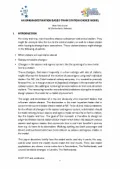-
Past ETC Papers

Browse, search and view papers from the past AET Conferences.
-
Members' Area

AET promotes networking and exchange of ideas, information and opportunities amongst members.
Conference Papers 2017
Barcelona, Spain
ETC Conference Papers 2017
An origin-destination based train station choice model
Seminar
Day 1 (4 Oct 2017), Session 1, Forecasting, 11:30 - 13:30
Status
Accepted, documents submitted
Submitted by / Abstract owner
Mats Verschuren
Authors
Mats Verschuren, NS
Short abstract
The goal of this research is to develop an origin-destination based station choice model. It calculates the number of train travellers per station in the future and is used as a tool for making decisions in the railway timetable design process.
Abstract
For every train trip, train travellers choose a departure and arrival station. They might for example take the bus to the central station, or walk to a local station while having to change trains somewhere. These station choices might change in the following situations:
1. When stations are opened or closed
2. Railway timetable changes
3. Changes in the access and egress system, like the opening of a new metro line to a station.
These changes, that occur frequently in urban settings with lots of stations, might influence the forecast of the number of passengers using each individual station. For NS, the Dutch national railway company, it is needed to precisely forecast this, as it may give cause to (logistical) changes in the operation of the railway system, like adding or removing train connections or train sets at certain stations. The increasing need for more detailed predictions during the timetable design process thus calls for a model improvement. Given that the most important factors for station choices are the origin and destination of the trip, the goal of the research described in this paper is to develop an origin-destination based station choice model that is well able to predict the effects of the three mentioned changes. In order to calculate the effects of changes in the access and egress system, it distinguishes among walking, cycling, car and bus/tram/metro as means to travel to and from the station.
The objective was to create a model that represents best a real train traveller’s journey from e.g. its home to its destination. To do so, one should know exactly how many people travel from each postal code to any other postal code in the country: a massive amount of data that is not available. It was however found that such information could be derived by combining data of the number of train travellers from station to station with survey data that include the exact origins and destinations of train travellers. Then, based on outcomes of this research on train travellers’ (station choice) behaviour, the model calculates via which station and by which access or egress mode he or she might logically travel, and which option probably will be chosen.
The question then is whether the model works well to forecast the effects of the three mentioned changes. To check this, the model has been validated using several cases, which include a new metro line in Amsterdam, several national timetable changes and newly opened stations. It can be concluded that the new model works well to predict station choices as the model outcomes are logical and within the bandwidth of the revealed results. The model is therefore now incorporated in NS’ forecasting model.
The model is then, among others, applied to calculate the effects of the new North-South metro line in Amsterdam, which runs between the Amsterdam Central and South stations. The results show that station choice is indeed a complex phenomenon, especially in urban settings with lots of stations: after opening the metro line, a lot of train travellers will, as expected, choose the South station at the expense of the Central station. However, the effects at some surrounding stations that are not connected by the new metro line will be even bigger: they will lose lots of train travellers that will choose the Central or South stations from then onward, due to the fast new metro connection.
The model thus gives interesting and detailed insights that otherwise would be unknown, and is able to do so for all three mentioned situations. The information derived from the model can be a very helpful tool for making decisions in the timetable design process, in order to design railway timetables that better match train travellers’ needs and wishes. The methodology is generic, so the philosophy used in the model is also suitable for other railway operating companies.
Documents:

Association For
European Transport
Forester House
Doctors Lane
Henley-in-Arden
Warwickshire, UK
B95 5AW
+44 (0) 15 64 793552
VAT number: 710 1866 64
Conference Supporters & Endorsers




Legal Entity
The Association for European Transport is registered as an Association ('vereniging') with the Chamber of Commerce for Haaglanden in The Netherlands under company number 27170096.
Built on Zenario




